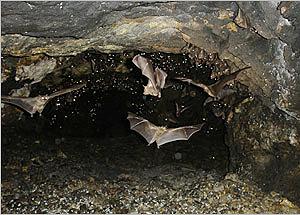tags: researchblogging.org, Egyptian Rousette, Egyptian fruit bat, Rousettus aegyptiacus, Marburg hemorrhagic fever virus, Ebola hemorrhagic fever virus, Uganda, zoonoses, pathogen
Like something out of a sci-fi novel, a man from Uganda died a horrible, bloody death from Marburg hemorrhagic fever this past July. As a result, scientists from the USA and the African nation of Gabon raced to the area to search for the source of this disease, and they may have finally discovered it. The team tested more than 1,000 bats that were captured in caves in Gabon and DR Congo, and discovered that some individuals of one species were infected with Marburg virus. The suspect bat, pictured above, is the Egyptian Rousette or Egyptian fruit bat, Rousettus aegyptiacus.
"Identifying Marburg infection in the African fruit bats brings us one step closer to understanding this deadly disease," said Eric Leroy, one of the study's authors. The study is the 2007 World Health report that is scheduled to be released in Geneva today and was also published in PLoS ONE last night.
Marburg virus causes a contagious and highly deadly hemorrhagic disease for which there is no known cure or vaccine. Marburg disease has an abrupt onset signaled by a high fever, severe headache, nausea and extreme malaise. It causes its unfortunate victims to bleed uncontrollably from multiple sites and is often rapidly fatal. Marburg hemorrhagic fever virus is closely related to the even more deadly Ebola hemorrhagic fever virus. These two viruses are fortunately quite rare, since they are among the most virulent pathogens known to infect humans, causing an 80-90 percent mortality rate.
 The Egyptian fruit bat was first identified as a potential source of this virus after experts from the Center for Disease Control (CDC), the National Institute of Communicable Diseases in South Africa and the World Health Organization (WHO) captured and tested them (pictured right. Image: Chris Black courtesy WHO). The team caught a variety of bat species using mist nets placed near the entrance to a lead and gold mine in a remote forest reserve in western Uganda. After the bats were captured, blood and tissues were collected and stored in liquid nitrogen until they were examined for the presence of Marburg virus.
The Egyptian fruit bat was first identified as a potential source of this virus after experts from the Center for Disease Control (CDC), the National Institute of Communicable Diseases in South Africa and the World Health Organization (WHO) captured and tested them (pictured right. Image: Chris Black courtesy WHO). The team caught a variety of bat species using mist nets placed near the entrance to a lead and gold mine in a remote forest reserve in western Uganda. After the bats were captured, blood and tissues were collected and stored in liquid nitrogen until they were examined for the presence of Marburg virus.
 Approximately five million bats of several species live in and around the small mine (pictured left. Image: Pierre Formenty courtesy WHO), which is located in Kitaka, about 300 km (200 miles) from Uganda's capital Kampala. Rousettus aegypticus bats range widely across sub-Saharan Africa, an area that has been repeatedly hit by the virus in the past. Egyptian Rousettes are nocturnal bats that rely on echolocation to navigate. Their wingspan averages 60 centimeters, their bodies are around 15 centimeters long and they weigh approximately 160 grams. They are usually light brown in color, and their wings are a darker brown color. They have large pointed ears, dark eyes, and a long dog-like face, so they are sometimes referred to as flying foxes. Egyptian fruit bats are frugivorous, consuming wild dates as well as almost any other soft, pulpy fruits.
Approximately five million bats of several species live in and around the small mine (pictured left. Image: Pierre Formenty courtesy WHO), which is located in Kitaka, about 300 km (200 miles) from Uganda's capital Kampala. Rousettus aegypticus bats range widely across sub-Saharan Africa, an area that has been repeatedly hit by the virus in the past. Egyptian Rousettes are nocturnal bats that rely on echolocation to navigate. Their wingspan averages 60 centimeters, their bodies are around 15 centimeters long and they weigh approximately 160 grams. They are usually light brown in color, and their wings are a darker brown color. They have large pointed ears, dark eyes, and a long dog-like face, so they are sometimes referred to as flying foxes. Egyptian fruit bats are frugivorous, consuming wild dates as well as almost any other soft, pulpy fruits.
Currently, there is no precise evidence indicating how Marburg virus is transmitted from bats to humans.
This research was published in PLoS ONE.
Sources
"Marburg Virus Infection Detected in a Common African Bat" by Jonathan S. Towner, Xavier Pourrut, César G. Albariño, Chimène Nze Nkogue, Brian H. Bird, Gilda Grard, Thomas G. Ksiazek, Jean-Paul Gonzalez, Stuart T. Nichol, Eric M. Leroy. PLoS ONE 2(8): e764. doi:10.1371/journal.pone.0000764 [Free PDF]
BBCNews (quotes)
Environment News (quotes, images)
- Log in to post comments


Wrong link - could you delete and replace with this one please.
I think I saw some speculation about transmission to humans occurring through gathering and consuming fruit contaminated by the bats while they were eating and presumably defecating or urinating.
Both intriguing and a little alarming given the nature of the disease.